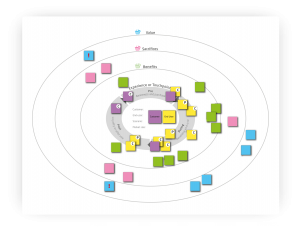

About the tool
The Circular Economy Customer and End-user Journey Map can help you to configure the value proposition for your business model. Use the tool to define what value or set of experiences should be delivered to customers and end-users based on their perception of benefits and sacrifices (i.e. price, effort to take products back). The idea is to optimise the balance between benefits and sacrifices in a way that the customers will still value the proposition and resource decoupling targets can be achieved. It is important to have a Circular Economy business model idea before using this tool.
The tool and process of application were inspired by a Master Thesis developed within the context of the CIRCit project (Nielsen, 2019).
How to apply the tool?
Step 1: Describe customers and end-users
Start on the center of the poster, by describing who the customers (i.e. buys and pays for the offering,) and end-users, (i.e. uses the offering) are. If customers are different than end-users, use different colored sticky notes. Include estimations of the potential market size and your expected share.
Step 2: Add the experiences and touchpoints
Using the sticky notes, list the experiences that the end-users go through, in their relation to the offering. Follow the suggested journey on the poster, going from the Pre, through During, and lastly Post contact with the offering. Identify, with white stickers, the experiences that require touchpoints with your company (C) or other potential partners (P).
Step 3: Add benefits
After identifying their journey, analyse where and which benefits could appear for the customers or users as a consequence of the new business model (e.g. enhanced convenience and flexibility; reduced costs or initial investments).
Step 4: Add sacrifices
Outline possible sacrifices to customers and users, as they could present risks for the solution that shall be mitigated (e.g. resistance to loss of products ownership; effort to return products).
Step 5: Estimate the value generation potential
Make a qualitative evaluation of benefits and sacrifices, to identify if benefits outweigh sacrifices and identify the potential value to customers and users. Indicate when and where value is degraded, presenting risks. Iterate and adjust to mitigate risks.
When to apply the tool?
The Circular Economy Customer and End-user Journey Map should be used in the seize stage to help defining and refining how the new business model(s) will look like.

The Circular Economy Customer and End-user Journey Map is one of the tools presented in the CIRCit project to help in the development of Circular Economy Business Models (WP2). Read more about the results of this focus area, explore other tools and download the inspiring workbook here.
Downloads
References:
Nielsen, A. K. (2019) A user-driven innovation approach to create business models for circular economy: A case in the textile and fashion industry. Master Thesis, Technical University of Denmark..
